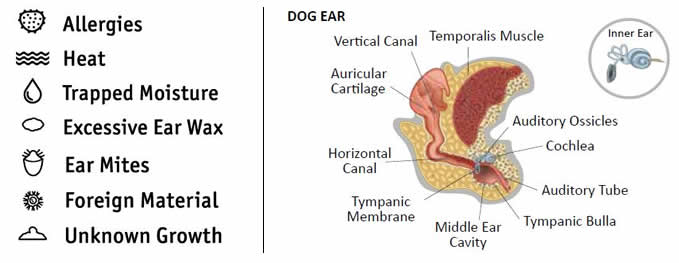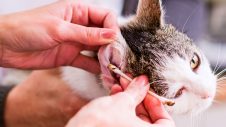Ear infections (Otitis Externa)
Ear infections, also referred to as otitis externa, are a common problem among our furry friends, especially those with long ears. If left untreated, they can cause extreme discomfort and further health problems.
Many types of infectious bacteria, fungi, parasites, and foreign materials may cause inflammation and infection in the outer, middle, or inner ears.
Dogs’ and cats’ ear canals are shaped like a long ‘L’. They are great for hearing, but this shape predisposes them to collect debris and moisture. The most common causes of ear disease include allergies, heat and trapped moisture, excessive earwax, ear mites, foreign material like grass seed, or an unknown growth or polyp.
Causes of pet ear infections

Some breeds, particularly those with floppy or hairy ears, such as cocker spaniels, poodles, or golden retrievers, are more prone to ear infections. However, they can occur in any breed.
Healthy ears are generally pink, clean, and have an unobtrusive smell. A pet suffering from an ear infection could show a number of symptoms.
What can cause an ear infection?
Ear mites can cause an ear infection, but this occurs most commonly in younger pets. Several types of infectious bacteria, yeast, and fungus might cause an ear infection. Without knowing the kind of infection present, it is difficult to treat effectively. In some cases, a foreign body or growth in the ear canal may cause the ear to become irritated. Treatment with medication alone will not resolve these problems. It is essential to have your pet’s eardrums examined to ensure they are intact. This is necessary because certain medications can result in loss of hearing if the eardrum is ruptured. The diagnosis is made by a veterinarian.
Symptoms of an ear infection
- Ears appear red/inflamed, and a black/brown or yellow/green discharge may be seen
- Strong odour
- Constant ear scratching or shaking of the head
- Swelling around the ear
- Whimpering due to discomfort.
Or more seriously
- Loss of balance
- Hearing loss
- Unusual eye movements
- Walking in circles or head tilting.
Ears are very sensitive. If you feel your pet may have a problem, please contact your local Greencross Vet. Having your pet’s ears examined by a veterinarian will allow them to determine whether the eardrum is intact or if there are any foreign materials in the ear canal. Vets can also obtain a sample for further diagnostics. Your vet will diagnose the cause of the problem and provide the best treatment and home care plan to combat the condition and have your pet in top shape once again.
How are pet ear infections diagnosed?
A thorough clinical examination, including examining your pet’s skin, assessing the eardrum to ensure it is intact, taking a small sample of the ear contents and looking under the microscope will allow your veterinarian to determine the cause of the disease. When a pet is in extreme pain and does not allow the examination, it may be necessary to sedate or anaesthetise the pet for a more thorough examination and diagnosis.
How are ear infections treated?
In many cases, ear drops can be applied to the affected ear. If foreign matter or excess discharge is in the ear canal, the pet may need to be sedated or anaesthetised so that it can be removed prior to the ear drops being administered. Sometimes, more than one type of infection could be diagnosed, and this may require the use of multiple medications. Your veterinarian will recommend a tailored treatment plan based on the diagnosis.
Aftercare at home
- Follow the medication directions that your veterinarian has advised.
- Only use medications prescribed by your veterinarian.
- Avoid the ears getting wet – no swimming, and only wash the head with a damp cloth.
Preventing a reoccurrence
- Please follow all veterinary home care instructions to the end of the course.
- Check your pet’s ears regularly.
- If you notice any recurring symptoms, please make an appointment with your vet.
Remember, all breeds of dogs and cats are susceptible to ear infections. Carefully watch for signs of tenderness, discharge, redness or odour from your pet’s ears.
If you suspect that they have an ear infection or irritation, contact your local Greencross Vet for more information.

 Greencross Vets
Greencross Vets 







